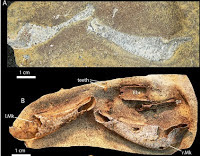Despite extending for
almost 2000 miles, the west coast of South Africa is home to
relatively few fossil-producing marine deposits. Two sites that are
particularly productive are the Miocene-Pliocene deposits at
Duinefontein and Langebaanweg, which have produced material
attributed to a variety of different Whales and Sharks as well as
Teleost Fish, other Marine Mammals and Birds, which are helping
scientists to develop an understanding of the environment and
ecological relationships present on the west South African Coast at
that time.
In a paper published in
the South African Journal of Science on 27 November 2015, Romala Govender of the Natural History Department at the Iziko Museums of South Africa, describes a series of fragmentary Whale bones from
Duinefontein which show score marks attributed to the actions of
Sharks.
The material comes from
the Shark Tooth Bed at Duinefontein which is thought to be about 5
million years old, making it early Pliocene, and is extremely
fragmentary, as well as showing wear signs consistent with having
been roled on a beach prior to its eventual burrial, all of which
prevents assignation of the bones to any particular Whale. The Shark
Tooth Bed, as well as producing numerous Shark Teeth has produced a
variety of Fish, Mammals and Birds, though most of the material is
fragmentary; the bed is thought to have been laid down behind a
barrier spit that was overtopped by spring tides or storm events, it
has been suggested that it may even be a tsunami deposit.
The Cetacean (Whale)
material from this site comprises vertebral centra, tympanic bullae,
periotics, isolated teeth and cranial fragments. Several of the
fragments, particularly those from the cranium and jaws, show score
marks and patterns of groves consistent with a Shark having bitten
down upon the bone then pulled backwards, a method of feeding common
in the modern Great White Shark, Carcharodon carcharias.
(a) CF2 bite marks on
the lateral surface of cranial fragment (SAMPQMB-D-1342) (arrow 1,
arrow 2). (b) CF2 bite mark on ventral surface of SAMPQMB-D-1342. (c)
B1 bite mark on the lateral surface of a mandibular fragment
(SAMPQMB-D-1182). (d) B2 bite mark on the small cranial fragment
(SAMPQMB-D-1339) (arrow). (e) B2 bite mark on cranial fragment
(SAMPQMB-D-1340) (inset close-up of damage). (f) B2 bite mark on the
lateral surface of cranial fragment (SAMPQMB-D-1342) (inset close-up
of damage). Govender (2015).
Such bite marks around
the head are typical of Sharks feeding on dead Whales, which tend to
concentrate their efforts around the head, where preferred food items
such as the tongue are found, though this does not preclude the Whale
having died as a result of a Shark attack. The exact nature of the
attacker cannot be determined from the material, though it would have
been a Shark with non-serated teeth such as a Great White, a species
that specializes in this sort of feeding and the which numerous teeth
of have been found at Duinefontein (and which is still present on
the same area of coast today). Other Sharks known to have been
present on the west South African Coast during the Early Pliocene
include Mako Sharks, Isurus sp. and Cosmopolitodus
hastalis, Ragged Tooth Sandtigers, Carcharias tarsus,
Megalodon Carcharodon megalodon,
and possibly Lemon Shark Negaprion
brevirostris.
See also...
 Carcharocles megalodon: Did the Megashark get bigger over time? The largest Shark ever to live
was Carcharocles megalodon, which
reached sizes of about eighteen meters and survived from the Middle Miocene
until the end of the Pliocene. This was formerly thought to...
Carcharocles megalodon: Did the Megashark get bigger over time? The largest Shark ever to live
was Carcharocles megalodon, which
reached sizes of about eighteen meters and survived from the Middle Miocene
until the end of the Pliocene. This was formerly thought to... Gogoselachus lynnbeazleyae: The first recorded Shark from the Late Devonian Gogo Formation of Western Australia.
Gogoselachus lynnbeazleyae: The first recorded Shark from the Late Devonian Gogo Formation of Western Australia.
The
deepest evolutionary split in the jawed vertebrates (Gnathostomes) is
that between the Sharks (Chondrichthyes) and Bony Fish (Osteichthyes),
with all terrestrial vertebrates forming a subgroup within...
The Main Devonian Field outcrops on the northwestern East European Platform in Estonia, Latvia, Lithuania, northern Belarus...
Follow Sciency Thoughts on
Facebook.


